NCERT Solutions for Exercise 14.3 Class 10 Maths Chapter 14 - Statistics
CBSE Class 10th Exam Date:01 Jan' 26 - 14 Feb' 26
This exercise teaches the approach to compute median values within datasets divided into categories. The median functions as the central value in datasets after performing an ascending order arrangement. A deep understanding of median calculation from frequency distributions becomes vital since this method provides key information about data centralisation. This exercise shows why median measurements matter in practical applications, which include both income distribution analysis and examination scores and population age examinations.
This Story also Contains
- NCERT Solutions Class 10 Maths Chapter 13 Exercise 13.3
- Assess NCERT Solutions for Class 10 Maths Chapter 13 Exercise 13.3
- Topics Covered in Chapter 13 Statistics: Exercise 13.3
- NCERT Solutions for Class 10 Subject Wise
- NCERT Exemplar Solutions of Class 10 Subject Wise

Students will identify the median class and apply the right formula to compute the median through this assignment. The NCERT Solutions preserve their structure based on the newest books introduced for the educational year 2025–26. The given solutions show students how to apply step-by-step procedures for median computation, which improves their ability to understand data described in the NCERT Books. Knowing this concept enables learners to use their apply the learned skills in economics and healthcare sectors and social studies since knowledge of data central values remains vital.
Assess NCERT Solutions for Class 10 Maths Chapter 13 Exercise 13.3
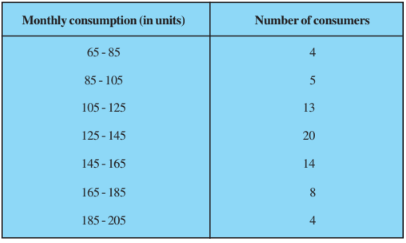
Answer:
First, we need to find the cumulative frequency and also let the assumed mean be a = 130 and h = 20 and will make the table as follows:
Class | Number of consumers $f_i$ | Cumulative Frequency | Classmark $x_i$ | $d_i = x_i -a$ | $u_i = \frac{d_i}{h}$ | $f_iu_i$ |
65-85 | 4 | 4 | 70 | -60 | -3 | -12 |
85-105 | 5 | 9 | 90 | -40 | -2 | -10 |
105-125 | 13 | 22 | 110 | -20 | -1 | -13 |
125-145 | 20 | 42 | 130 | 0 | 0 | 0 |
145-165 | 14 | 56 | 150 | 20 | 1 | 14 |
165-185 | 8 | 64 | 170 | 40 | 2 | 16 |
185-205 | 4 | 68 | 190 | 60 | 3 | 12 |
$\sum f_i = N$ = 68 | $\sum f_ix_i$ = 7 |
MEDIAN:
As, $N= 68 \implies \frac{N}{2} = 34$
Therfore, Median class = 125-145; Cumulative Frequency = 42; Lower limit, l = 125; c.f. = 22; f = 20; h = 20
$Median = l + \left (\frac{\frac{n}{2}-c.f}{f} \right ).W$
After putting the values, we get:
$\\ = 125 + \left (\frac{34-22}{20} \right ).20 \\ \\ = 125 + 12$
$= 137$
Thus, the median of the data is 137
MODE:
The class having the maximum frequency is the modal class.
The maximum frequency is 20, and hence the modal class = 125 - 145
Lower limit (l) of modal class = 125, class size (h) = 20
Frequency ( $f_1$ ) of the modal class = 20
Frequency ( $f_0$ ) of class preceding the modal class = 13
Frequency ( $f_2$ ) of class succeeding the modal class = 14.
Therefore, $Mode = l + \left(\frac{f_1-f_0}{2f_1 - f_0 - f_2} \right).h$
After putting the values, we get:
$\\ = 125 + \left(\frac{20-13}{2(20)-13-14} \right).20 \\ \\ = 125 + \frac{7}{13}.20$
$= 135.76$
Thus, the Mode of the data is 135.76
MEAN:
$\overline x =a + \frac{\sum f_iu_i}{\sum f_i}\times h$
After putting the values, we get:
$= 130 + \frac{7}{68}\times20 = 137.05$
Thus, the Mean of the data is 137.05
Q2 If the median of the distribution given below is 28.5, find the values of x and y.
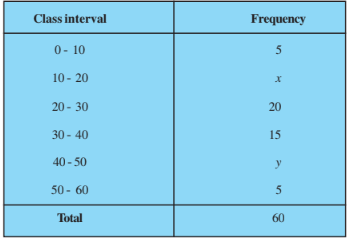
Answer:
Class | Number of consumers $f_i$ | Cumulative Frequency |
0-10 | 5 | 5 |
10-20 | x | 5+x |
20-30 | 20 | 25+x |
30-40 | 15 | 40+x |
40-50 | y | 40+x+y |
50-60 | 5 | 45+x+y |
$\sum f_i = N$ = 60 |
As, $N= 60 \implies \frac{N}{2} = 30$
Given median = 28.5, which lies in the class 20-30
Therefore, Median class = 20-30
Frequency corresponding to median class, f = 20
Cumulative frequency of the class preceding the median class, c.f. = 5 + x
Lower limit, l = 20; Class height, h = 10
Thus, $Median = l + \left (\frac{\frac{n}{2}-c.f}{f} \right ).W$
After putting the values, we get:
$\\ \implies28.5= 20 + \left (\frac{30-5-x}{20} \right ).10 \\ \\ \implies8.5=\frac{25-x}{2} \\ \implies 25-x = 8.5(2) \\ \implies x = 25 - 17 = 8$
Also,
$\\ 60 = 45 + x+y \\ \implies x+y = 60-45 = 15 \\ \implies y = 15-x = 15-8 \ \ \ (\because x =8) \\ \implies y = 7$
Therefore, the required values are: x=8 and y=7
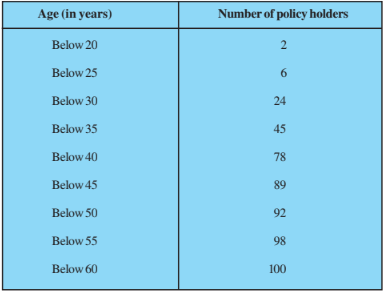
Answer:
Class | Frequency $f_i$ | Cumulative Frequency |
15-20 | 2 | 2 |
20-25 | 4 | 6 |
25-30 | 18 | 24 |
30-35 | 21 | 45 |
35-40 | 33 | 78 |
40-45 | 11 | 89 |
45-50 | 3 | 92 |
50-55 | 6 | 98 |
55-60 | 2 | 100 |
Given, $N= 100 \implies \frac{N}{2} = 50$
Therefore, Median class = 35-45
Frequency corresponding to median class, f = 21
Cumulative frequency of the class preceding the median class, c.f. = 24
Lower limit, l = 35; Class height, h = 10
Therefore, $Median = l + \left (\frac{\frac{n}{2}-c.f}{f} \right ).W$
After putting in the values, we get:
$\\ = 35 + \left (\frac{50-45}{33} \right ).5 \\ \\$
$= 35.75$
Thus, the median age is 35.75 years.
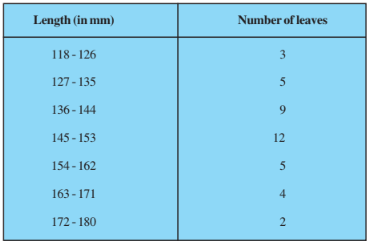
Find the median length of the leaves.
(Hint: The data needs to be converted to continuous classes for finding the median since the formula assumes continuous classes. The classes then change to
117.5 - 126.5, 126.5 - 135.5, . . ., 171.5 - 180.5.)
Answer:
The data needs to be converted to continuous classes for finding the median, since the formula assumes continuous classes.
Class | Frequency $f_i$ | Cumulative Frequency |
117.5-126.5 | 3 | 3 |
126.5-135.5 | 5 | 8 |
135.5-144.5 | 9 | 17 |
144.5-153.5 | 12 | 29 |
153.5-162.5 | 5 | 34 |
162.5-171.5 | 4 | 38 |
171.5-180.5 | 2 | 40 |
As,$ N= 40 \implies \frac{N}{2} = 20$
Therefore, Median class = 144.5-153.5
Lower limit, l = 144.5; Class height, h = 9
Frequency corresponding to median class, f = 12
Cumulative frequency of the class preceding the median class, c.f. = 17
$Median = l + \left (\frac{\frac{n}{2}-c.f}{f} \right ).W$
After putting in the values, we get:
$\\ = 144.5 + \left (\frac{20-17}{12} \right ).9 \\ \\$
$= 146.75$
Thus, the median length of the leaves is 146.75 mm
Q5 The following table gives the distribution of the lifetime of 400 neon lamps: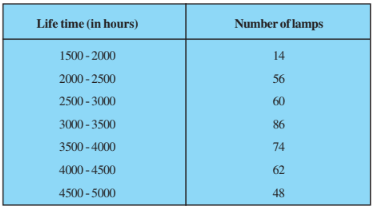
Find the median lifetime of a lamp.
Answer:
Class | Frequency $f_i$ | Cumulative Frequency |
1500-2000 | 14 | 14 |
2000-2500 | 56 | 70 |
2500-3000 | 60 | 130 |
3000-3500 | 86 | 216 |
3500-4000 | 74 | 290 |
4000-4500 | 62 | 352 |
4500-5000 | 48 | 400 |
$ N= 400 \implies \frac{N}{2} = 200$
Therefore, Median class = 3000-3500
Lower limit, l = 3000; Class height, h = 500
Frequency corresponding to median class, f = 86
Cumulative frequency of the class preceding the median class, c.f. = 130
$Median = l + \left (\frac{\frac{n}{2}-c.f}{f} \right ).W$
After putting in the values, we get:
$\\ = 3000 + \left (\frac{200-130}{86} \right ).500 \\ \\ = 3000+406.97$
$= 3406.97$
Thus, the median lifetime of a lamp is 3406.97 hours
$= 146.75$
Thus, the median length of the leaves is 146.75 mm

Determine the median number of letters in the surnames. Find the mean number of letters in the surnames? Also, find the modal size of the surnames.
Answer:
Class | Number of surnames $f_i$ | Cumulative Frequency | Classmark $x_i$ | $f_ix_i$ |
1-4 | 6 | 6 | 2.5 | 15 |
4-7 | 30 | 36 | 5.5 | 165 |
7-10 | 40 | 76 | 8.5 | 340 |
10-13 | 16 | 92 | 11.5 | 184 |
13-16 | 4 | 96 | 14.5 | 51 |
16-19 | 4 | 100 | 17.5 | 70 |
$\sum f_i = N$ = 100 | $\sum f_ix_i$ = 825 |
MEDIAN:
$N= 100 \implies \frac{N}{2} = 50$
$\therefore$ Median class = 7-10; Lower limit, l = 7;
Cumulative frequency of preceding class, c.f. = 36; f = 40; h = 3
$Median = l + \left (\frac{\frac{n}{2}-c.f}{f} \right ).W$
After putting in the values, we get:
$\\ = 7+ \left (\frac{50-36}{40} \right ).3 \\ \\$
$= 8.05$
Thus, the median of the data is 8.05
MODE:
The class having the maximum frequency is the modal class.
The maximum frequency is 40, and hence the modal class = 7-10
Lower limit (l) of modal class = 7, class size (h) = 3
Frequency ( $f_1$ ) of the modal class = 40
Frequency ( $f_0$ ) of class preceding the modal class = 30
Frequency ( $f_2$ ) of class succeeding the modal class = 16
$Mode = l + \left(\frac{f_1-f_0}{2f_1 - f_0 - f_2} \right).h$
After putting in the values, we get:
$\\ = 7 + \left(\frac{40-30}{2(40)-30-16} \right).3 \\ \\ = 125 + \frac{10}{34}.3$
$= 7.88$
Thus, the Mode of the data is 7.88
MEAN:
$\overline x =\frac{\sum f_ix_i}{\sum f_i}$
$= \frac{825}{100} = 8.25$
Thus, the Mean of the data is 8.25

Answer:
Class | Number of students $f_i$ | Cumulative Frequency |
40-45 | 2 | 2 |
45-50 | 3 | 5 |
50-55 | 8 | 13 |
55-60 | 6 | 19 |
60-65 | 6 | 25 |
65-70 | 3 | 28 |
70-75 | 2 | 30 |
MEDIAN:
$N= 30 \implies \frac{N}{2} = 15$
Therefore, Median class = 55-60; Lower limit, l = 55;
Cumulative frequency of preceding class, c.f. = 13; f = 6; h = 5
$Median = l + \left (\frac{\frac{n}{2}-c.f}{f} \right ).W$
After putting in the values, we get:
$\\ = 55+ \left (\frac{15-13}{6} \right ).5 \\ \\ = 55+\frac{2}{6}.5$
$= 56.67$
Thus, the median weight of the student is 56.67 kg
Also Read-
Topics Covered in Chapter 13 Statistics: Exercise 13.3
1. Understanding Median for Grouped Data: The concept of Median for grouped data demonstrates how central values separate statistical sets into two balanced sections for data that includes class intervals.
2. Identifying the Median Class: The process of identifying the Median Class enables you to find which interval contains the median because it serves as the fundamental step for calculating the median in grouped data.
3. Applying the Median Formula: When calculating the median, apply statistical formulas that include the lower end of the median class, its width and cumulative frequency figures.
4. Solving Real-Life Based Word Problems: The resolution of real-life word problems requires frequency tables that stem from actual survey results or performance scores to find the central value.
5. Interpreting Data Trends: Students should learn to recognise meaningful conclusions based on trends and patterns within frequency groups of raw data.
Check Out:
NCERT Solutions for Class 10 Subject Wise
Students must check the NCERT solutions for class 10 of the Mathematics and Science Subjects.
NCERT Exemplar Solutions of Class 10 Subject Wise
Students must check the NCERT Exemplar solutions for class 10 of the Mathematics and Science Subjects.
Frequently Asked Questions (FAQs)
Median gives the value of the observation which is at the center so it is dependent on either the observation is odd number or even number. Practice ex 14.3 class 10 to command these concepts.
The concept related to discusses in class 10 ex 14.3. Formula of median of odd observation is n/2th observation. Students can practice ex 14.3 class 10 to get deeper understanding of concepts.
The concepts related to median is discussed in class 10 maths ex 14.3. Formula of median of even observation is (n/2+ 1 )th observation. Also practice class 10 ex 14.3 which is discussed in this article to get deeper understanding of the concepts.
3 Median = Mode + 2 Mean is the relation between mean, medium and mode as mentioned in Class 10 maths chapter 14 exercise 14.3.
These concepts are discussed in 10th class maths exercise 14.3 answers. practice them to command the concepts. Cumulative Frequency Table is the cumulative frequency is calculated by adding each frequency from a frequency distribution table to the sum of its predecessors.
Questions related to CBSE Class 10th
On Question asked by student community
Hi! If you’re looking for the Class 11 English half yearly question paper for 2025-26 (CBSE board), you’ll find the right resource once you check the link provided from Careers360. Solving previous or sample papers is a smart way to prepare, as it helps you understand the question types, marking scheme, and important topics. This practice will boost your confidence and help you manage your time well in the actual exam.
https://school.careers360.com/boards/cbse/cbse-class-11-half-yearly-sample-papers-2025-26
Hi dear candidate,
Could you please specify us the board of education for which you need the half yearly question papers of class X so that we can help you further.
Below are few links which may help you and it has all the subjects with English as well:
CBSE Class 10 Half Yearly Exam Question Paper 2025-26 with Answer Key & Analysis
ICSE Class 10 Half Yearly Sample Papers 2025-26 PDF (All Subjects)
BEST REGARDS
Hi dear candidate,
Can you please specify the board of education or state for which you need to know the exam pattern and syllabus so that we can guide you accordingly.
Since, most of the boards uses NCERT as base syllabus, you can refer to the link below:
NCERT Syllabus for Class 10 – All Subjects PDF Download 2025-26
Exam pattern:
CBSE 10th New Exam Pattern 2026- Marking Scheme, Subject-Wise Exam Pattern
BEST REGARDS
The CBSE Class 10th Board Exams for the 2026 session will follow the revised curriculum, emphasizing competency-based questions.
-
Conducting Body: Central Board of Secondary Education (CBSE).
-
Exam Period: The main theory exams are typically held between February and April 2026.
-
Grading: Based on marks in five main subjects plus internal assessment marks (often 20 marks per subject) provided by the school.
-
Passing Criteria: You must achieve at least 33% overall in each subject (theory + practical/internal assessment combined) to be declared pass.
Key Preparation Strategy
The most crucial element of your preparation is understanding the exam structure:
-
Syllabus: Strictly adhere to the rationalized syllabus released by CBSE for the 2025-26 academic year.
-
Practice: Your primary resource should be the latest sample papers and previous year question papers. These accurately reflect the format and types of competency questions being asked.
For the most comprehensive and official announcements, including the detailed time table and access to crucial practice materials, always check the official board updates, as tracked by Careers360: https://school.careers360.com/exams/cbse-class-10th .
HELLO,
If you want admission to 9th grade under the CBSE board in Andhra Pradesh , visit nearby CBSE affiliated schools during the admission period that is generally from January to April or you can check the official websites of the schools in which you are interested for admission if they are accepting the admissions now .
After deciding the school and getting information about admission deadline from the school you can fill out the admission form with documents submission like your previous report card , transfer certificate and birth certificate , they make take entrance test or interview to confirm your admission
To know more visit :- https://school.careers360.com/schools/cbse-schools-in-andhra-pradesh
Hope this Helps!
Applications for Admissions are open.
As per latest syllabus. Physics formulas, equations, & laws of class 11 & 12th chapters
JEE Main Important Chemistry formulas
Get nowAs per latest syllabus. Chemistry formulas, equations, & laws of class 11 & 12th chapters
JEE Main high scoring chapters and topics
Get nowAs per latest 2024 syllabus. Study 40% syllabus and score upto 100% marks in JEE
JEE Main Important Mathematics Formulas
Get nowAs per latest syllabus. Maths formulas, equations, & theorems of class 11 & 12th chapters
